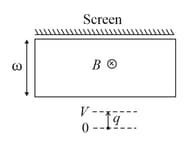A charge particle of mass having charge is accelerated by certain potential difference starting from rest. Particle moves on a straight line when it is projected perpendicularly in a region where electric field and magnetic field are perpendicular to each other. Value of potential difference is :-
Important Questions on Magnetic Effect of Current
| Column 1 | Column 2 | Column 3 |
| 1. Electron with | (i) | (P) |
| 2. Electron with | (ii) | (Q) |
| 3.Proton with | (iii) | (R) |
| 4. Proton with | (iv) | (S) |
| Column 1 | Column 2 | Column 3 |
| 1. Electron with | (i) | (P) |
| 2. Electron with | (ii) | (Q) |
| 3.Proton with | (iii) | (R) |
| 4. Proton with | (iv) | (S) |
In which case would the particle move in a straight line along the negative direction of y axis
| Column 1 | Column 2 | Column 3 |
| 1. Electron with | (i) | (P) |
| 2. Electron with | (ii) | (Q) |
| 3.Proton with | (iii) | (R) |
| 4. Proton with | (iv) | (S) |
In which case will the particle describe a helical path with axis along positive z direction?
A rectangular region of dimensions has a constant magnetic field into the plane of the paper as shown. On one side the region is bounded by a screen. On the other side positive ions of mass and charge are accelerated from rest and towards the screen by a parallel plate capacitor at constant potential difference , and come out through a small hole in the upper plate. Which one of the following statements is correct regarding the charge on the ions that hit the screen?

Two parallel metal plates and separated by a distance are connected to an ammeter. Photons of energy are incident on the photosensitive plate of threshold wavelength . The minimum value of the magnetic field to be applied parallel to the plates so that the current through the ammeter becomes zero is . Then the value of
is (mass of electron , charge of electron )

